Understanding Batteries
Understanding Batteries and Battery Charging
![]() For any solar installation, understanding batteries and how we can use them in an off-grid or stand alone system is not as hard as you may think. These days we use simple batteries in just about every electrical device, to power our phones, laptops, remote controls, lamps or other such portable equipment and there are a bewildering range of battery types and sizes to do just that, so why not use batteries to power our homes.
For any solar installation, understanding batteries and how we can use them in an off-grid or stand alone system is not as hard as you may think. These days we use simple batteries in just about every electrical device, to power our phones, laptops, remote controls, lamps or other such portable equipment and there are a bewildering range of battery types and sizes to do just that, so why not use batteries to power our homes.
Batteries store electrical energy on their internal plates in the form of a chemical charge, and once fully charged, an ideal battery could store this potential energy indefinitely until released through an externally connected load.
However, batteries are not ideal and due to internal leakage currents or parasitic loads batteries will slowly discharge themselves when not in use but until then they can store electrical energy for very long periods of time. Then we can say that a battery is an energy storage device capable of storing and producing electricity until it is needed.
Understanding Battery Specifications
Electrical energy in the form of a DC (Direct Current) supply is created from a battery as the result of a chemical reaction which occurs between two metal plates, one called the positive electrode and the other called the negative electrode which are both immersed in a chemical solution called an electrolyte.
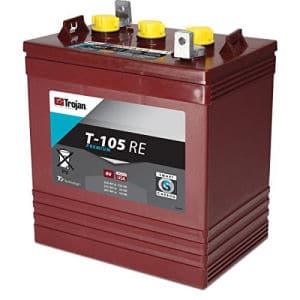
This electrolytic solution that separates the batteries electrodes can be classed as either “dry”. For example, a lithium powder or gel type which you would find in a standard AA battery. Or classed as being “wet”, having a liquid electrolyte as you would find in older lead acid automotive battery which required topping-up with distilled water.
Either way the combination of two different electrodes placed within an electrolytic solution forms the basis of one single battery voltaic cell. Solid state batteries have a solid electrolyte/separator to prevent the electrodes from shorting together.
Batteries form two basic types, Primary Batteries and there are Secondary Batteries. Primary batteries are your typical use once and throw away batteries from small 1.5 volt flat button and cylindrical AA and AAA type batteries, through to the larger square 9.0 volt PP3 and spring terminal lantern batteries.
A primary battery cannot be recharged. However, secondary batteries are rechargeable type batteries from the small AA types for your TV remote control to the rechargeable batteries for your power tools to car batteries and through to the larger deep cycle batteries used for electric vehicles and supply house power loads throughout the night.
The type of battery required depends on the application and power discharging requirements, and this is also true of solar powered battery systems. There is no point buying one type of battery because it is cheap if it discharges after only one hour of use.
Then the Ampere-hour rating (Ah) of a battery is an important specification to understanding battery storage capacity and the amount of electrical current it can supply over a specific period of time before needing to be recharged.
Connecting Batteries in Series
Individual batteries are connected together in “series” to increase the output terminal voltage while keeping the amp-hour rating the same as for a single battery. The negative (–ve) terminal of the first battery is connected directly to the positive (+ve) terminal of the second battery, and so on as shown.
Batteries Connected in Series
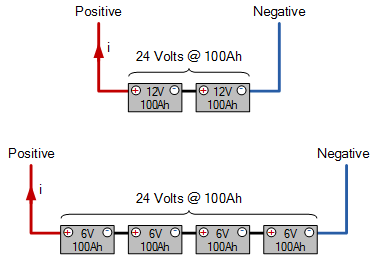
Understanding batteries connected in a series string is fairly straight forward, you just add their voltages together. In the example shown, two 12 volt batteries are connected together and four 6 volt batteries are connected together in a series string to create a 24 volt system. By connecting more batteries together, higher voltage strings of 36V or 48V can be created by adding the voltage of each battery to give the total voltage output.
For series connected batteries, ideally all the batteries should be of the same ampere-hour (Ah) rating, make or age as each battery will receive the same amount of current when being re-charged, so differences in battery capacity across the series string can result in the lower rated batteries to become overcharge while the higher rated batteries may remain undercharged.
Also remember that for series connected batteries, the maximum output current will be determined by the lowest rated amp-hour battery within the string. For example, if you have four batteries rated at 100Ahrs and one battery rated at 80Ahrs, the 80Ahr battery controls the series string, so connect your batteries wisely.
Individual batteries connected together in series increases the output voltage, while the current stays the same. Since power (P) is calculated as the sum of Voltage (V) times Current (I) (P = V*I in watts), then increasing the series voltage while the current stays the same, increases the available power. In the example above, the stored battery power available is given as: 24V x 100Ahr = 2400Whr or 2.4kWhr
Although we talk of “batteries” as being a single source of dc power, batteries themselves consist of several individual “electromechanical cells” connected together in series within a single plastic case. Each cell on its own produces approximately 2 volts, so if the terminal voltage of a typical lead-acid deep-cycle battery is 12-volts, it will consist of six individual cells. Likewise, a 24-volt simple battery has twelve 2-volt cells and a 6-volt battery only three 2-volt cells.
Connecting Batteries in Parallel
Individual batteries are connected together in “parallel” to increase the output current, or Amp-hour storage capacity while the output terminal voltage remains the same as for a single battery. For parallel connected batteries, all the positive (+ve) terminals of each battery are connected together, and all the negative –ve terminals of each battery are also connected together as shown.
Batteries Connected in Parallel
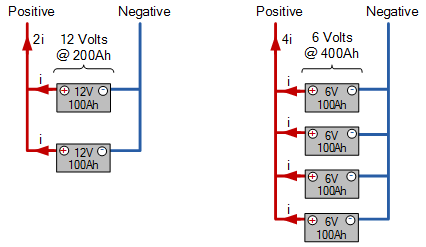
Batteries connected in parallel increases the amp-hour current rating which is the sum of the battery capacities added together, but the output terminal voltage remains the same as the voltage rating of one single battery.
So in the example shown above, the two 12 volt batteries connected together would produce 200Ah, while the four 6 volt batteries connected together in parallel would produce 400Ah of output capacity. Thus by connecting more batteries together in parallel, higher ampere-hour capacities can be obtained for the same voltage output.
You may think that connecting batteries together in parallel branches would give more available power, but this is not always the case. Part of understanding batteries is knowing how to connect them together to obtain the desired output power. In our example above, the battery power available on the first image is: 12V x 200Ahr = 2400Whr or 2.4kWhr, and for the second image: P = 6V x 400Ahr = 2400Whr or 2.4kWhr, the same.
It is important for parallel connected batteries that they are of the same rated voltage and of very similar amp-hour current ratings. This is because while they will receive the same single charging voltage, the charging current of each battery will vary slightly until equalisation of the battery bank is reached. One final point, the more parallel connected batteries you have, the larger may be the storage capacity but the longer it will take to fully recharge them.
Understanding Batteries in Series/Parallel Combinations
We saw above that when connecting batteries together in series, the voltage available is the sum of the battery voltages added together and when connected together in parallel, The total ampere-hour capacity available is the sum of the amp-hour capacities of the individual batteries.
But there are many different ways groups of batteries can be connected together in both series and parallel combinations to give a variety of different voltages and amp-hour capacities, especially for home solar systems that use deep-cycle batteries.
So it is not uncommon for off-grid battery banks to have a terminal voltage of several hundred volts and a total capacity of several hundred ampere-hours to power a whole home for many dull days or through the night.
Batteries Connected in Parallel
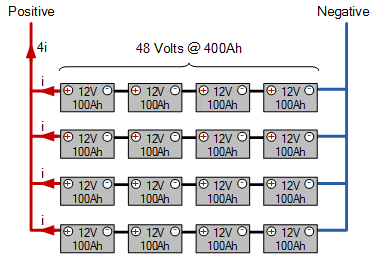
Deep-cycle battery banks for home solar use as well as those currently being installed in hybrid and electric vehicles (EV’s) generally consists of individual battery modules and cells arranged in series and parallel combinations to supply not only the required output system voltage, but the maximum amount of storage capacity available between battery recharging.
Understanding Batteries – Discharging
Understanding batteries also means understanding their state of charge and when it is required to recharge them. When a battery is connected to an external load, such as lights, pumps, inverters, etc. the chemical energy stored within the battery changes into electrical energy resulting in an electrical DC current flowing out of the battery and into the connected external circuit. Thus when discharging, a battery converts chemical energy into electrical energy.
If the battery is connected to the load for a long enough period of time, the energy stored within the battery gradually decreases and eventually stops as the battery cells loose their ability to generate a voltage. At this point, all the chemical energy contained or “stored” in the batteries electrolytic solution has been converted into electrical energy. The time this takes obviously will depend greatly on the connected load, and on the amp-hour capacity and storage volume of the battery cells.
So how would we know what is the condition of a battery and whether it is fully charged or discharged. Clearly there are many different types of batteries for use in renewable energy storage systems, from flooded or wet cell lead acid batteries, to AGM (Absorbed Glass Mat) and GEL batteries, to the newer lithium-ion (Li-ion) cells used in electric vehicles (EV). So one easy way to know the condition of a battery or cell is measure its State of Charge.
It’s All About The State Of Charge
The State of Charge (SOC) of a battery or cell gives the available capacity (in Ah) of the cell as a percentage of its total rated capacity. This is done by measuring the specific gravity (SG) of the electrolyte (battery acid) within each battery cell.
As there is a linear relationship between a battery cells open circuit terminal voltage (VOC) and its state-of-charge, by measuring a batteries voltage using just a multimeter, we can determine its state of charge. Thus understanding a batteries condition.
The state-of-charge estimation of a battery at any time is defined: SOC = (Amp-hour capacity remaining in the battery)/(Rated Ah capacity) and from this we can create an SOC table as shown.
12 Volt Battery State of Charge Condition
| Open Circuit Voltage | State of Charge |
|---|---|
| 12.65V | 100% |
| 12.58V | 90% |
| 12.55V | 80% |
| 12.48V | 70% |
| 12.40V | 60% |
| 12.32V | 50% |
| 12.24V | 40% |
| 12.10V | 30% |
| 11.90V | 20% |
| 11.70V | 10% |
| 11.30V | 0% |
In other words, if the state-of-charge of a fully charged storage battery is 100% (SOC = 100%) and is 0% when fully discharged, (SOC = 0%), respectively.
So for instance, a 300 amp-hour battery at a 70% state of charge will contain 210 amp-hours of stored energy, and at a 50% state of charge the same battery will contain 150 amp-hours, and so on.
Then the understanding batteries with regards to its SOC at any given instant can be easily determined by knowing the VOC of the battery with something like this Optimate State of Charge Tester capable of giving you an accurate measurement.
Thus we can see from the table that the open circuit voltage for a fully charged 12V lead-acid battery is approximately 12.7 Volts which equals an SOC of 100%, and drops to about 11.3 Volts, an SOC of 0% when fully discharged.
Fully discharging a lead-acid battery to this level should be avoided as this can damage the battery permanently due to the sulfation of the electrode plates, which is a build-up of lead sulfate crystals. To ensure good performance and longevity of the battery, a minimum 30% state-of-charge of the remaining capacity is generally recommended.
Understanding Batteries – Charging
Understanding batteries state-of-charge, is a quick and easy way of determining the condition of a battery by simply measuring its open terminal voltage and if its required to charge it. Charging a cell or whole battery is effectively the reverse of the discharging process, in that electrical energy is converted into chemical energy which the battery stores until it is needed.
Secondary batteries can be recharged using a variety of charge controllers connected to the mains utility line, back-up generators, wind turbines or using the free the electrical energy generated by photovoltaic panels, that is “Solar Panels”, when exposed directly to sunlight. Either way, to use electrical energy to recharge batteries, it needs to go through a voltage charge controller.
The number, wattage size or quantity of photovoltaic panels needed to sufficiently charge a single battery or an interconnected battery bank, will depend on the quantity and Amp-hour rating of the batteries being used.
In stand-alone systems, the output voltage of the photovoltaic (PV) array should match that of the battery storage capacity and from this an appropriate charge controller can be selected to ensure that the battery charge controller delivers the appropriate amount of charge when needed and will not overcharge the batteries.
The principle job of a charge controller is to protect the batteries from overcharging, prevent unwanted or deep-cycle discharging, and provide information about the batteries state of charge and there are three main types of charge controllers available to do just that: Series, Shunt (parallel controllers), and Maximum Power Point (MPP) controllers. Each with its own set off advantages and disadvantages.
Sometimes a charge controller may not be needed, for instance if the battery is constantly being used and discharged, or if you are using low wattage self-regulating solar panels for charging a single or shallow-cycle battery for camping, hiking, or field trips, etc.
Batteries for renewable energy systems are the so-called “deep cycle” batteries that can withstand periods of long or continuous discharging cycles and repeated recharging. These operate with high efficiency and long duration. But how many deep-cycles can a deep-cycle battery tolerate.
Understanding Batteries Summary
Understanding batteries means understanding the characteristics of the batteries you have. Generally, the service life of a battery is a function of not only the number of charging cycles, but the discharge depth of cycling. The number of deep cycles a battery can withstand varies greatly from manufacturer to manufacturer and also on the make, model and storage temperature of the battery, or batteries but a range of 1000 to 1200 charging cycles is not uncommon.
Obviously lead-acid batteries which have a charging cycle of only 60 or 70% depth of charge will last longer than those which are discharged to 10 or 20% of battery capacity. A battery or bank which which has been discharged to below 20% state of charge is said to be “deep cycled”.
Deep-cycle battery banks which are well maintained, shallow cycled to a lower capacity of less than 10% of the battery’s energy per cycle, and properly recharged using a suitable charge controller can last up to 10 years or more.
Learn In Understanding Batteries and Battery Charging
To learn more about deep cycle batteries, battery charging, and the state-of-charge battery monitoring devices available, or maybe you just want to explore the advantages and disadvantages of energy storage systems for understanding batteries in a more detailed way.
Whatever the reasons, if you have already given it some serious thought, but may not know how to go about determining the feasibility of using photovoltaic power and battery storage for off-grid living.
Then order your copy of: The Battery Builders Guide from Amazon today, and get a greater understanding of batteries and how to build, rebuild and recondition lead-acid batteries.





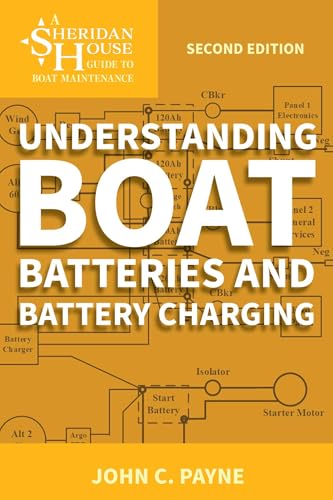




Thank you for your helpful article . With all the misinformation surrounding electric vehicle I was wondering what are the limiting factors in battery charging . EG I seldom us my car once a week ? and when I do I don’t drive far . Therefore my car sits idle for the majority of the time . Would it be possible to charge , (what are the limiting factors ) to me getting a small caravan solar system to maintain the charge on my car. , would it limit the life of the batteries ?
Electric and hybrid cars have a battery pack voltage of between 300 to 800 volts depending on the make and model to power its electric motors. But hybrid cars also have a normal 12 volt cranking battery to start its internal combustion engine and power its lights and electrical systems, the same as for normal cars.
Therefore you could use a small caravan solar system to maintain charge in the 12V cranking battery, but not to charge the high-voltage battery pack. That requires a dedicated high-power charging system.
Please correct the obvious (hence not quoting) mistake here
So for batteries connected in series increases voltage but the current stays the same. Since power (P) is calculated as the sum of Voltage (V) times Current (I) (P = V*I in watts), then increasing the series voltage while the current stays the same, increases the available power and in the example above, the battery power available is given as: 24V x 100Ahr = 2400Whr or 2.4kWhr
Individual batteries connected together in series increases the output terminal voltage of the battery bank by the number of connected batteries as stated. In the example given, each 100 Ah battery has a terminal voltage of 6 volts. Thus connecting 4 together in series would give a battery bank output voltage of: 4 x 6 = 24 volts as correctly stated.
Also each 100 Ah, 6V battery has the potential to supply 600 Wh (6 x 100) of electrical energy. Thus 4 batteries connected together in series (or parallel) has the potential to supply 4 x 600 Wh = 24V x 100Ah = 2400Ah = 2400Wh = 2.4 kWh of electrical power as stated in the tutorial. Therefore, the tutorial is correct as given.
Your math is correct but kWh is not a measure of power it is a measure of energy
Electrical Energy, (E) is measured in terms of its capacity to do work, given in joules (J) with the time rate of doing the work expressed in joules per second, given in Watts, (W). That is the amount of work, W used during an amount of time, t defines the average power consumed, so one watt is equivalent to one joule per second (1W = 1 J/s).
Electrical Power, (P) is the rate at which energy is being used in a circuit, also measured in watts, (W). If “P” denotes the power supplied by the battery, then power, P in watts, is equal to the battery voltage times the current being supplied. P = VxI. Thus, the relationship between electric energy, E and electric power, P is given by time, t.
In the tutorial example, the electrical current capacity of the battery was declared as: 100 Amperes, and if it supplies this 100 amperes of electric current continuously for 1 hour, it will supply 100Ah of electrical energy. As we now know that electrical power is the rate at which energy is being used in watts. So for the battery bank example, 2400Ah = 2400Wh = 2.4 kWh of electrical power, or 2.4 kWh = 2400 W × 1 hour = 2400 W × 60 × 60 s = 8640 kJ of electrical energy.
Battery charger
Hi.ware can I get come 6 voltage batterys.
Internet, eBay, local solar supplier, local forktruck service centre, do some research
Thanks for your site and valuable information. I have 8 deep cycle 12v 72ah capacity batteries and I want to connect them in two rows of four batteries to give 48 volts for my inverter to power my lights. What would be the amp-hour rating? thanks in advance.
Each row or string would be 48 volts, 6 amperes, Thus two parallel strings would give a total output of 48 volts at 576 Amp-hours
Not 288Ah?
You did a great job of explaining that I can add two 12v 100Ah batteries as an additional parallel string giving 24v 300Ah. I’ve been thinking about it if it is possible because I am really unsure of it. I’d be interested to learn more of your tutorials, I really find it very useful and informative.